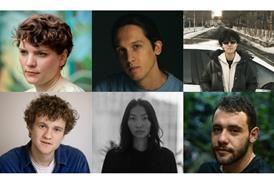Palestinian filmmaker Rashid Masharawi talks to Melanie Goodfellow about his documentary capturing life in the besieged Yarmouk refugee camp on the edge of Damascus.
One of the lesser-told stories of the Syrian civil war is the plight of the Palestinian residents of the Yarmouk refugee camp on the outskirts of Damascus.
Established in the late 1950s, the unofficial camp was a thriving residential and commercial centre and home to 160,000 Palestinians before the Syrian uprising in 2011.
Most of its residents have fled but some 20,000 people remain trapped in the camp, which is under siege with little access to food, water and medical supplies.
Palestinian filmmaker Rashid Masharawi’s powerful documentary Letters From Al Yarmouk, which premieres in DIFF’s Muhr feature competition, captures the deteriorating conditions.
Masharawi decided to make a documentary about the humanitarian crisis after he was contacted by Lamis Al Khatib, who told him about her boyfriend Niraz Saeed, a 23-year-old photographer trapped in the camp.
The resulting documentary combines Saeed’s material with a series of Skype interviews between Masharawi and the photographer as well as other residents in the camp and former inhabitants who have fled.
Why did you decide to make a film about the camp?
I was contacted by Niraz’ girlfriend Lamis, who is now living in Germany as a refugee. She told me that Niraz was stuck in the camp and was shooting video and stills all the time but didn’t know what to do with the material.
I agreed to take a look at it. I had no idea what the end result would be but said let’s start the process and see where it takes us.
I ended up following the events in the camp for eight months from February to November of 2014. We only finished the film two weeks ago and its premiere in Dubai will be the first time I’ll see it on the big screen.
Why did she contact you?
I’m a refugee from Jaffa born in a refugee camp in Gaza. I was born and grew up in the same situation as them. I’ve made many films in Palestinian refugee camps in Lebanon, Syria and Jordan, with refugees and about refugees. It’s part of my life. I think that’s why they approached me.
In the film, I also go to see where their parents came from in Palestine, Nahf, a village near Acre, which still exists, and another near Tiberius, which no longer exists.
The shooting process is interesting. You mix Skype interviews with Saeed’s footage. Can you talk a little about this?
Because I could not be there Saeed acted as my assistant director. As well as sending his footage and stills, Niraz would take his laptop out into the street and film for me while we were Skyping.
He was the conduit, going out getting me stories from Yarmouk, but at one point he became the story after his brother was killed in the middle of the night, shot by a sniper.
The Middle East conflict flared up in Gaza while you were making the film. Did this impact the film?
The film goes beyond Yarmouk. It ends up also discussing the situation in Ramallah, 1948 and the war in Gaza. At a certain point Niraz was filming protests in the streets of Yarmouk against what was going on in Gaza and people were Skyping me from the camp to check that my family in Gaza was OK.
What are your hopes for the film?
For me, it’s not just a film. It’s an issue and something humanity needs to deal with. I’m glad it’s in competition so we can raise a bit more attention to what’s going on through the media and the audience.
The Palestinians were quite integrated in Syria prior to the war. In Lebanon, there are 72 jobs Palestinians are not allowed to do. This was not the case in Syria. Before the war, Yarmouk was a big shopping centre for Damascus. People went there to buy food and spices.
Today, just some 20,000 people remain – some out of choice – they’re tired of moving and consider it their home. They’re stuck, but even if they could leave, they have nowhere to go as they’re already refugees. There’s no water, no electricity and bombs are going off all the time. It’s a complicated situation. There is no easy solution.

























No comments yet